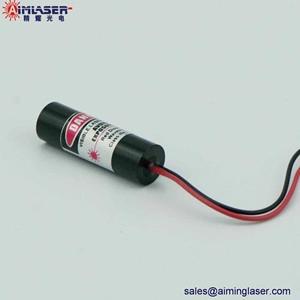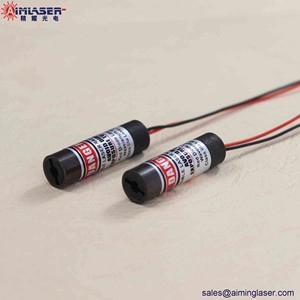Laser is a great invention in the 20th century, and it is called the fastest knife, the most accurate ruler and the brightest light. Laser (light amplification by stimulated emission of radiation), which means stimulated radiation light amplification, describes the principle of laser generation. Next, let's take a look at how the laser is produced.
The theory of stimulated radiation is the basis of laser generation, which was put forward by Einstein in 1917. There are two energy levels S1 and S2 in the laser gain medium, which correspond to the lower energy state and the upper energy state of the laser transition respectively. The energy difference E2–E1 between them is equal to hν. When the system is at the energy level S1 and irradiated by photons with energy hν, it has a certain probability to absorb photons and transition to the energy level S2. This process is called stimulated absorption. When the system is at the energy level S2, there is a certain probability that it will jump to the energy level S1 and release the fluorescent photon hν. This process is called spontaneous emission. If the system is at the energy level S2 and irradiated by hν, it has a certain probability to release a photon with the same frequency, phase 1 and propagation direction as the incident photon. This process is called stimulated radiation. If such a gain medium containing a large number of molecules at S2 energy level is placed between two opposite parallel mirrors, some fluorescence photons perpendicular to the mirrors can be amplified by stimulated radiation to form self-excited oscillation, thus emitting laser light. The optical element at the left end of the resonant cavity is called the output coupler, which is equivalent to a reflective surface with a certain transmittance, and is the outlet of the laser in the resonant cavity.
of the laser transition respectively. The energy difference E2–E1 between them is equal to hν. When the system is at the energy level S1 and irradiated by photons with energy hν, it has a certain probability to absorb photons and transition to the energy level S2. This process is called stimulated absorption. When the system is at the energy level S2, there is a certain probability that it will jump to the energy level S1 and release the fluorescent photon hν. This process is called spontaneous emission. If the system is at the energy level S2 and irradiated by hν, it has a certain probability to release a photon with the same frequency, phase 1 and propagation direction as the incident photon. This process is called stimulated radiation. If such a gain medium containing a large number of molecules at S2 energy level is placed between two opposite parallel mirrors, some fluorescence photons perpendicular to the mirrors can be amplified by stimulated radiation to form self-excited oscillation, thus emitting laser light. The optical element at the left end of the resonant cavity is called the output coupler, which is equivalent to a reflective surface with a certain transmittance, and is the outlet of the laser in the resonant cavity.
Generally, stimulated radiation is so weak that it is even difficult to observe, let alone use it to generate laser. When a substance is in thermal equilibrium, the distribution of molecules in energy levels obeys Boltzmann distribution. The number of particles N1 in the lower energy state S1 is far greater than the number of particles N2 in the upper energy state S2, and the absorption of hν photons is far greater than that of stimulated radiation, so it is impossible to realize optical signals macroscopically. The key of laser generation lies in the inversion of particle number, so that N2>N1. At present, when the laser works, it is necessary to adopt appropriate excitation (pumping) method to realize the inversion of the particle number at a specific energy level.
Taking dye laser as an example, this paper introduces how to realize particle number inversion. The gain medium of laser is organic dye solution. Commonly used dyes include coumarin in blue and violet bands, rhodamine in red and yellow bands, etc. The laser transition of organic dyes mainly occurs in the energy bands of S0 and S1 singlet states. These two energy  bands are composed of many rotational and vibrational energy levels, which can be regarded as continuous due to collision broadening in solution. In the process of laser generation, dye molecules are irradiated by the pump light to transition from the bottom energy level of the S0 band to the S1 band, and then rapidly transition to the bottom energy level of S1 through non-radiation, that is, the upper energy state of laser transition. In the laser transition, molecules transition to the specified energy level in the S0 energy band and release photons, and then quickly transition to the bottom energy level of the S0 energy band. Because the upper energy state S2 of laser transition has a long lifetime, while the lifetime of S1 is very short, and under the action of pump light, a large number of molecules are excited to the upper energy state S2, so the population inversion can be realized. At the same time of laser generation, dye molecules cross between S1 band generation systems, enter the triplet system with long life in T1, and leave the laser transition cycle, which affects the laser efficiency. Therefore, when the dye laser works, it is necessary to recycle the dye solution.
bands are composed of many rotational and vibrational energy levels, which can be regarded as continuous due to collision broadening in solution. In the process of laser generation, dye molecules are irradiated by the pump light to transition from the bottom energy level of the S0 band to the S1 band, and then rapidly transition to the bottom energy level of S1 through non-radiation, that is, the upper energy state of laser transition. In the laser transition, molecules transition to the specified energy level in the S0 energy band and release photons, and then quickly transition to the bottom energy level of the S0 energy band. Because the upper energy state S2 of laser transition has a long lifetime, while the lifetime of S1 is very short, and under the action of pump light, a large number of molecules are excited to the upper energy state S2, so the population inversion can be realized. At the same time of laser generation, dye molecules cross between S1 band generation systems, enter the triplet system with long life in T1, and leave the laser transition cycle, which affects the laser efficiency. Therefore, when the dye laser works, it is necessary to recycle the dye solution.
Many lasers have good monochromaticity, that is, the spectral bandwidth of the output light is narrow. Whether the output spectrum of laser is narrow or not is related to the following factors. First of all, the laser gain medium and pumping mode determine which wavelength band photons can be amplified. Such gain media as gas laser, excimer laser and Nd:YAG laser, which have sparse energy levels and narrow energy distribution, naturally produce laser with narrow linewidth. Secondly, the monochromaticity of laser can be adjusted by the resonant cavity. If it is necessary to produce laser with good monochromaticity, it is necessary to set the attenuation of different spectral components in the resonant cavity to amplify specific spectral components.